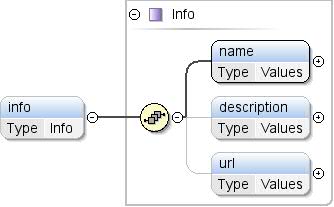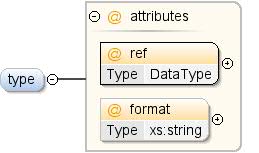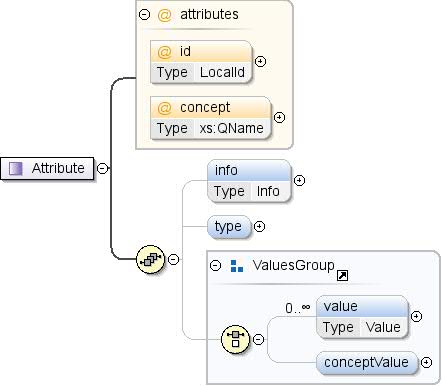Composant: attribut
Restez organisé à l'aide des collections
Enregistrez et classez les contenus selon vos préférences.
Élément: Attribut / infos
| Espace de noms |
http://schemas.google.com/dspl/2010 |
| Annotations |
Informations textuelles sur l'attribut. |
| Diagramme |
 |
| Type |
Infos |
| Propriétés |
| content: |
complexe |
| minOccurs: |
0 |
|
| Modèle |
name , description{0,1} , url{0,1} |
| Enfants |
description, name, url |
| Instance |
<info>
<name>{1,1}</name>
<description>{0,1}</description>
<url>{0,1}</url>
</info>
|
| Source |
<xs:element name="info" type="Info" minOccurs="0">
<xs:annotation>
<xs:documentation>Textual information about the attribute.</xs:documentation>
</xs:annotation>
</xs:element>
|
| Espace de noms |
http://schemas.google.com/dspl/2010 |
| Annotations |
Type de données de l'attribut. |
| Diagramme |
 |
| Propriétés |
| content: |
complexe |
| minOccurs: |
0 |
|
| Attributs |
| QName |
Type |
Fixe |
Par défaut |
Utiliser |
Annotation |
| format |
xs:string |
|
|
facultatif |
Un format pour la valeur, utilisé pour analyser un texte
la représentation des valeurs. Consultez les [spécifications des formats de date] pour en savoir plus
dates. |
| réf. |
DataType |
|
|
required |
|
|
| Source |
<xs:element name="type" minOccurs="0">
<xs:annotation>
<xs:documentation>The data type of the attribute.</xs:documentation>
</xs:annotation>
<xs:complexType>
<xs:attribute name="ref" type="DataType" use="required"/>
<xs:attribute name="format" type="xs:string" use="optional">
<xs:annotation>
<xs:documentation>A format for the value, used to parse a textual
representation of the values. See [Date formats spec]
for dates.</xs:documentation>
</xs:annotation>
</xs:attribute>
</xs:complexType>
</xs:element>
|
Type complexe: attribut
| Espace de noms |
http://schemas.google.com/dspl/2010 |
| Annotations |
Attribut d'ensemble de données ou concept. |
| Diagramme |
 |
| Utilisé par |
|
| Modèle |
info{0,1} , type{0,1} , (valeur*
| conceptValue{0,1}) |
| Enfants |
conceptValue, info, type,
valeur |
| Attributs |
| QName |
Type |
Fixe |
Par défaut |
Utiliser |
Annotation |
| concept |
xs:QName |
|
|
facultatif |
Une référence à un concept qui correspond aux valeurs
de l'attribut. Si l'attribut indique un type, alors le type
doit correspondre au type du concept référencé. Une référence à un
concept externe doit se présenter sous la forme
"prefix:other_concept_id", où "prefix" correspond à
Préfixe utilisé pour l'espace de noms de l'ensemble de données externe (voir XML
espaces de noms). |
| id |
LocalId |
|
|
facultatif |
Identifiant de l'attribut de concept. Cet identifiant doit être
est unique au sein du concept (pour les attributs et les propriétés). La
L'identifiant peut être omis si l'attribut concept est spécifié. Dans ce
un identifiant est créé implicitement avec la valeur "nom local"
de référence. Par exemple, <attribute
concept="unit:currency"/> équivaut à
<attribute id="currency"
concept="unit:currency"/> |
|
| Source |
<xs:complexType name="Attribute">
<xs:annotation>
<xs:documentation>An attribute of a dataset or a concept.</xs:documentation>
</xs:annotation>
<xs:sequence>
<xs:element name="info" type="Info" minOccurs="0">
<xs:annotation>
<xs:documentation>Textual information about the attribute.</xs:documentation>
</xs:annotation>
</xs:element>
<xs:element name="type" minOccurs="0">
<xs:annotation>
<xs:documentation>The data type of the attribute.</xs:documentation>
</xs:annotation>
<xs:complexType>
<xs:attribute name="ref" type="DataType" use="required"/>
<xs:attribute name="format" type="xs:string" use="optional">
<xs:annotation>
<xs:documentation>A format for the value, used to parse a textual
representation of the values. See [Date formats spec]
for dates.</xs:documentation>
</xs:annotation>
</xs:attribute>
</xs:complexType>
</xs:element>
<xs:group ref="ValuesGroup" minOccurs="0"/>
</xs:sequence>
<xs:attribute name="id" type="LocalId" use="optional">
<xs:annotation>
<xs:documentation>The id of the concept attribute. This identifier must be unique within the concept
(across attributes and properties).
The id may be omitted if the concept attribute is specified. In that case, an id is
implicity created with value the local name of the referenced concept. For instance
<attribute concept="unit:currency"/>
is equivalent to
<attribute id="currency" concept="unit:currency"/></xs:documentation>
</xs:annotation>
</xs:attribute>
<xs:attribute name="concept" type="xs:QName" use="optional">
<xs:annotation>
<xs:documentation>A reference to a concept that corresponds to the values of the attribute.
If the attribute specifies a type, then the type must match the type of
the referenced concept.
A reference to an external concept must be of the form "prefix:other_concept_id",
where "prefix" is the prefix used for the namespace of the external dataset
(see XML namespaces).</xs:documentation>
</xs:annotation>
</xs:attribute>
</xs:complexType>
|
| Espace de noms |
Aucun espace de noms |
| Type |
DataType |
| Propriétés |
| utilisez les lignes ci-dessous : |
required |
|
| Attributs |
| énumération |
chaîne |
|
| énumération |
float |
|
| énumération |
entier |
|
| énumération |
booléen |
|
| énumération |
date |
|
| énumération |
concept |
|
|
| Utilisé par |
|
| Source |
<xs:attribute name="ref" type="DataType" use="required"/>
|
| Espace de noms |
Aucun espace de noms |
| Annotations |
Format de la valeur, utilisé pour analyser une représentation textuelle.
des valeurs. Consultez la section [Spécification des formats de date] pour en savoir plus sur les dates. |
| Type |
xs:string |
| Propriétés |
| utilisez les lignes ci-dessous : |
facultatif |
|
| Utilisé par |
|
| Source |
<xs:attribute name="format" type="xs:string" use="optional">
<xs:annotation>
<xs:documentation>A format for the value, used to parse a textual
representation of the values. See [Date formats spec]
for dates.</xs:documentation>
</xs:annotation>
</xs:attribute>
|
| Espace de noms |
Aucun espace de noms |
| Annotations |
Identifiant de l'attribut de concept. Cet identifiant doit être unique
au sein du concept (pour les attributs et les propriétés). L'ID peut être
est omise si l'attribut conceptuel est spécifié. Dans ce cas, un identifiant est
implicite créée avec la valeur "nom local du concept référencé".
Par exemple : <attribute concept="unit:currency"/> correspond à
équivaut à <attribute id="currency"
concept="unit:currency"/> |
| Type |
LocalId |
| Propriétés |
| utilisez les lignes ci-dessous : |
facultatif |
|
| Attributs |
|
| Utilisé par |
|
| Source |
<xs:attribute name="id" type="LocalId" use="optional">
<xs:annotation>
<xs:documentation>The id of the concept attribute. This identifier must be unique within the concept
(across attributes and properties).
The id may be omitted if the concept attribute is specified. In that case, an id is
implicity created with value the local name of the referenced concept. For instance
<attribute concept="unit:currency"/>
is equivalent to
<attribute id="currency" concept="unit:currency"/></xs:documentation>
</xs:annotation>
</xs:attribute>
|
Attribut: Attribut / @concept
| Espace de noms |
Aucun espace de noms |
| Annotations |
Une référence à un concept qui correspond aux valeurs du
. Si l'attribut spécifie un type, le type doit correspondre.
le type de concept référencé. Une référence à un concept externe
doit être au format "prefix:other_concept_id", où
"préfixe" est le préfixe utilisé pour l'espace de noms de l'instance
(voir "Espaces de noms XML"). |
| Type |
xs:QName |
| Propriétés |
| utilisez les lignes ci-dessous : |
facultatif |
|
| Utilisé par |
|
| Source |
<xs:attribute name="concept" type="xs:QName" use="optional">
<xs:annotation>
<xs:documentation>A reference to a concept that corresponds to the values of the attribute.
If the attribute specifies a type, then the type must match the type of
the referenced concept.
A reference to an external concept must be of the form "prefix:other_concept_id",
where "prefix" is the prefix used for the namespace of the external dataset
(see XML namespaces).</xs:documentation>
</xs:annotation>
</xs:attribute>
|
Créé à l'aide de la méthode
Éditeur XML oXygen
Sauf indication contraire, le contenu de cette page est régi par une licence Creative Commons Attribution 4.0, et les échantillons de code sont régis par une licence Apache 2.0. Pour en savoir plus, consultez les Règles du site Google Developers. Java est une marque déposée d'Oracle et/ou de ses sociétés affiliées.
Dernière mise à jour le 2025/07/25 (UTC).
[[["Facile à comprendre","easyToUnderstand","thumb-up"],["J'ai pu résoudre mon problème","solvedMyProblem","thumb-up"],["Autre","otherUp","thumb-up"]],[["Il n'y a pas l'information dont j'ai besoin","missingTheInformationINeed","thumb-down"],["Trop compliqué/Trop d'étapes","tooComplicatedTooManySteps","thumb-down"],["Obsolète","outOfDate","thumb-down"],["Problème de traduction","translationIssue","thumb-down"],["Mauvais exemple/Erreur de code","samplesCodeIssue","thumb-down"],["Autre","otherDown","thumb-down"]],["Dernière mise à jour le 2025/07/25 (UTC)."],[],["The core content describes the structure and properties of an \"Attribute\" within a dataset or concept. An attribute can include optional textual information (`info`), its data `type` (required), and value. The `type` specifies the data type and can have a `format`. Attributes have an optional `id` for unique identification and can refer to another `concept`. The `info` section may include name, description, and URL.\n"]]



